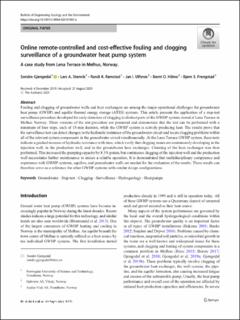| dc.contributor.author | Gjengedal, Sondre | |
| dc.contributor.author | Stenvik, Lars Aaberg | |
| dc.contributor.author | Ramstad, Randi Kalskin | |
| dc.contributor.author | Ulfsnes, Jan Ivar | |
| dc.contributor.author | Hilmo, Bernt Olav | |
| dc.contributor.author | Frengstad, Bjørn S. | |
| dc.date.accessioned | 2022-03-07T14:59:41Z | |
| dc.date.available | 2022-03-07T14:59:41Z | |
| dc.date.created | 2020-11-06T11:11:45Z | |
| dc.date.issued | 2021 | |
| dc.identifier.citation | Bulletin of Engineering Geology and the Environment. 2021, 80 1063-1072. | en_US |
| dc.identifier.issn | 1435-9529 | |
| dc.identifier.uri | https://hdl.handle.net/11250/2983553 | |
| dc.description.abstract | Fouling and clogging of groundwater wells and heat exchangers are among the major operational challenges for groundwater heat pump (GWHP) and aquifer thermal energy storage (ATES) systems. This article presents the application of a step-test surveillance procedure developed for early detection of clogging in distinct parts of the GWHP system, tested at Lena Terrace in Melhus Norway. Three versions of the test procedure are presented and demonstrate that the test can be performed with a minimum of four steps, each of 15-min duration, while the GWHP system is actively producing heat. The results prove that the surveillance test can detect changes in the hydraulic resistance of the groundwater circuit and locate clogging problems within all of the relevant system components in the groundwater circuit simultaneously. At the Lena Terrace GWHP system, these tests indicate a gradual increase of hydraulic resistance with time, which verify that clogging issues are continuously developing in the injection well, in the production well, and in the groundwater heat exchanger. Cleaning of the heat exchanger was then performed. This increased the pumping capacity by 8.3% points, but continuous clogging of the injection well and the production well necessitates further maintenance to ensure a reliable operation. It is demonstrated that multidisciplinary competence and experience with GWHP-systems, aquifers, and groundwater wells are needed for the evaluation of the results. These results can therefore serve as a reference for other GWHP systems with similar design configurations. | en_US |
| dc.language.iso | eng | en_US |
| dc.publisher | Springer | en_US |
| dc.rights | Navngivelse 4.0 Internasjonal | * |
| dc.rights.uri | http://creativecommons.org/licenses/by/4.0/deed.no | * |
| dc.title | Online remote-controlled and cost-effective fouling and clogging surveillance of a groundwater heat pump system | en_US |
| dc.type | Peer reviewed | en_US |
| dc.type | Journal article | en_US |
| dc.description.version | publishedVersion | en_US |
| dc.source.pagenumber | 1063-1072 | en_US |
| dc.source.volume | 80 | en_US |
| dc.source.journal | Bulletin of Engineering Geology and the Environment | en_US |
| dc.identifier.doi | 10.1007/s10064-020-01963-z | |
| dc.identifier.cristin | 1845552 | |
| cristin.ispublished | true | |
| cristin.fulltext | original | |
| cristin.fulltext | original | |
| cristin.qualitycode | 1 | |

